Advances in Thermal Management Technologies of Electrical Machines
Abstract
:1. Introduction
2. Enclosed Housing Cooling
3. Enhanced Conductive Cooling
4. Embedded Heat Pipe Cooling
5. Direct Oil Cooling
6. Enhanced Rotor Cooling
7. Summary and Conclusions
Author Contributions
Funding
Institutional Review Board Statement
Informed Consent Statement
Data Availability Statement
Conflicts of Interest
References
- Cheng, M.; Sun, L.; Buja, G.; Song, L. Advanced Electrical Machines and Machine-Based Systems for Electric and Hybrid Vehicles. Energies 2015, 8, 9541–9564. [Google Scholar] [CrossRef] [Green Version]
- Kumar, L.; Jain, S. Electric Propulsion System for Electric Vehicular Technology: A Review. Renew. Sustain. Energy Rev. 2014, 29, 924–940. [Google Scholar] [CrossRef]
- Ho, S.L.; Wang, Q.; Niu, S.; Fu, W.N. A Novel Magnetic-Geared Tubular Linear Machine with Halbach Permanent-Magnet Arrays for Tidal Energy Conversion. IEEE Trans. Magn. 2015, 51, 1–4. [Google Scholar]
- Ozturk, S.; Fthenakis, V.; Faulstich, S. Failure Modes, Effects and Criticality Analysis for Wind Turbines Climatic Regions and Comparing Geared and Direct Drive Wind. Energies 2018, 11, 2317. [Google Scholar] [CrossRef]
- Xie, P.; Vakil, G.; Gerada, C. Electric Drive Systems with Long Feeder Cables. IET Electr. Power Appl. 2020, 14, 16–30. [Google Scholar] [CrossRef]
- Saghin, S.M.; Ghaheri, A.; Shirzad, H.; Afjei, E. Performance Optimisation of a Segmented Outer Rotor Flux Switching Magnet Motor for Direct Drive Washing Machine Application. IET Electr. Power Appl. 2021, 15, 1574–1587. [Google Scholar] [CrossRef]
- Wang, Q.; Niu, S. Overview of Flux-Controllable Machines: Electrically Excited Machines, Hybrid Excited Machines and Memory Machines. Renew. Sustain. Energy Rev. 2017, 68, 475–491. [Google Scholar] [CrossRef]
- Wang, Q.; Niu, S. A Novel DC-Coil-Free Hybrid-Excited Machine with Consequent-Pole PM Rotor. Energies 2018, 11, 700. [Google Scholar] [CrossRef] [Green Version]
- Mao, Y.; Niu, S.; Wang, Q. Design and Optimization of a Slot-PM-Assisted Doubly-Salient Machine Based on Saturation Assuaging. Chin. J. Electr. Eng. 2021, 7, 65–72. [Google Scholar] [CrossRef]
- Wang, Q.; Niu, S. A Novel Hybrid-Excited Flux Bidirectional Modulated Machine for Electric Vehicle Propulsion. In Proceedings of the 2016 IEEE Vehicle Power and Propulsion Conference (VPPC), Hangzhou, China, 17–20 October 2016; pp. 1–6. [Google Scholar]
- Pothi, N.; Zhu, Z.Q.; Afinowi, I.A.A.; Lee, B.; Ren, Y. Control Strategy for Hybrid-Excited Switched-Flux Permanent Magnet. IET Electr. Power Appl. 2015, 9, 612–619. [Google Scholar] [CrossRef]
- Ullah, N.; Khan, F.; Basit, A.; Shahzad, M. Experimental Validations of Hybrid Excited Linear Flux Switching Machine. Energies 2021, 14, 7274. [Google Scholar] [CrossRef]
- Ali, Q.; Hussain, A.; Baloch, N.; Kwon, B. Design and Optimization of a Brushless Wound-Rotor Vernier Machine. Energies 2018, 11, 317. [Google Scholar] [CrossRef] [Green Version]
- Liang, D.; Zhu, Z.Q.; Zhang, Y.; Feng, J.; Guo, S.; Li, Y.; Wu, J.; Zhao, A. A Hybrid Lumped-Parameter and Two-Dimensional Analytical Thermal Model for Electrical Machines. IEEE Trans. Ind. Appl. 2021, 57, 246–258. [Google Scholar] [CrossRef]
- Rostami, N.; Feyzi, M.R.; Pyrhonen, J.; Parviainen, A.; Niemela, M. Lumped-Parameter Thermal Model for Axial Flux Permanent Magnet Machines. IEEE Trans. Magn. 2013, 49, 1178–1184. [Google Scholar] [CrossRef]
- Graffeo, F.; Vaschetto, S.; Miotto, A.; Carbone, F.; Tenconi, A.; Cavagnino, A. Lumped-Parameters Thermal Network of PM Synchronous Machines for Automotive Brake-by-Wire Systems. Energies 2021, 14, 5652. [Google Scholar] [CrossRef]
- Zhou, K.; Pries, J.; Hofmann, H. Computationally Efficient 3-D Finite-Element-Based Dynamic Thermal of Electric Machines. IEEE Trans. Transp. Electrif. 2015, 1, 138–149. [Google Scholar] [CrossRef]
- Boglietti, A.; Cossale, M.; Popescu, M.; Staton, D.A. Electrical Machines Thermal Model: Advanced Calibration Techniques. IEEE Trans. Ind. Appl. 2019, 55, 2620–2628. [Google Scholar] [CrossRef]
- Mellor, P.H.; Yon, J.; Baker, J.L.; North, D.; Booker, J.D. Electromagnetic and Thermal Coupling within a Fault-Tolerant Aircraft Propulsion Motor. In Proceedings of the 2017 IEEE International Electric Machines and Drives Conference, Miami, FL, USA, 21–24 May 2017. [Google Scholar]
- Valenzuela, M.A.; Tapia, J.A. Heat Transfer and Thermal Design of Finned Frames for TEFC Variable-Speed Motors. IEEE Trans. Ind. Electron. 2008, 55, 3500–3508. [Google Scholar] [CrossRef]
- Ulbrich, S.; Kopte, J.; Proske, J. Cooling Fin Optimization on a TEFC Electrical Machine Housing Using a 2-D Conjugate Heat Transfer Model. IEEE Trans. Ind. Electron. 2018, 65, 1711–1718. [Google Scholar] [CrossRef]
- Gilson, G.M.; Pickering, S.J.; Hann, D.B.; Gerada, C. Piezoelectric Fan Cooling: A Novel High Reliability Electric Machine Thermal Management Solution. IEEE Trans. Ind. Electron. 2013, 60, 4841–4851. [Google Scholar] [CrossRef]
- Gilson, G.M.; Pickering, S.J.; Hann, D.B.; Gerada, C. High Reliability Piezoelectric Fan Cooling for Electric Machine Thermal Management. In Proceedings of the 6th IET International Conference on Power Electronics, Machines and Drives (PEMD 2012), Bristol, UK, 27–29 March 2012; pp. 1–6. [Google Scholar]
- Zhang, B.; Qu, R.; Member, S.; Fan, X.; Wang, J.; Analysis, A.E.F. Thermal and Mechanical Optimization of Water Jacket of Permanent Magnet Synchronous Machines for EV Application. In Proceedings of the 2015 IEEE International Electric Machines & Drives Conference, Coeur d’Alene, ID, USA, 10–13 May 2015. [Google Scholar]
- Yang, X.; Fatemi, A.; Nehl, T.; Hao, L.; Zeng, W.; Parrish, S. Comparative Study of Three Stator Cooling Jackets for Electric Machine of Mild Hybrid Vehicle. IEEE Trans. Ind. Appl. 2021, 57, 1193–1201. [Google Scholar] [CrossRef]
- Liang, P.; Chai, F.; Shen, K.; Liu, W. Thermal Design and Optimization of a Water-Cooling Permanent Magnet Synchronous in-Wheel Motor. In Proceedings of the 2019 22nd International Conference on Electrical Machines and Systems (ICEMS), Harbin, China, 11–14 August 2019; pp. 1–6. [Google Scholar]
- Xu, Z.; Galea, M.; Tighe, C.; Hamiti, T.; Gerada, C.; Pickering, S.J. Mechanical and Thermal Management Design of a Motor for an Aircraft Wheel Actuator. In Proceedings of the 2014 17th International Conference on Electrical Machines and Systems, ICEMS 2014, Hangzhou, China, 22–25 October 2014; pp. 3268–3273. [Google Scholar]
- Galea, M.; Gerada, C.; Raminosoa, T.; Wheeler, P. A Thermal Improvement Technique for the Phase Windings of Electrical Machines. IEEE Trans. Ind. Appl. 2012, 48, 79–87. [Google Scholar] [CrossRef]
- Wrobel, R.; Hussein, A. A Feasibility Study of Additively Manufactured Heat Guides for Enhanced Heat Transfer in Electrical Machines. IEEE Trans. Ind. Appl. 2020, 56, 205–215. [Google Scholar] [CrossRef] [Green Version]
- Polikarpova, M.; Lindh, P.M.; Tapia, J.A.; Pyrhönen, J.J. Application of Potting Material for a 100 KW Radial Flux PMSM. In Proceedings of the Proceedings—2014 International Conference on Electrical Machines, Berlin, Germany, 2–5 September 2014; pp. 2146–2151. [Google Scholar]
- Vansompel, H.; Sergeant, P. Extended End-Winding Cooling Insert for High Power Density Electric Machines with Concentrated Windings. IEEE Trans. Energy Convers. 2020, 35, 948–955. [Google Scholar] [CrossRef]
- Madonna, V.; Walker, A.; Giangrande, P.; Serra, G.; Gerada, C.; Galea, M. Improved Thermal Management and Analysis for Stator End-Windings of Electrical Machines. IEEE Trans. Ind. Electron. 2019, 66, 5057–5069. [Google Scholar] [CrossRef]
- Zhang, X.; Zhang, C.; Fu, P.; Zhang, C.; Li, L. A Novel Cooling Technique for the Windings of High-Torque-Density Permanent Magnet Machines. In Proceedings of the 2018 21st International Conference on Electrical Machines and Systems (ICEMS), Jeju, Korea, 7–10 October 2018; pp. 332–337. [Google Scholar]
- Rhebergen, C.; Bilgin, B.; Emadi, A.; Rowan, E.; Lo, J. Enhancement of Electric Motor Thermal Management through Axial Cooling Methods: A Materials Approach. In Proceedings of the 2015 IEEE Energy Conversion Congress and Exposition (ECCE), Montreal, QC, Canada, 20–24 September 2015; pp. 5682–5688. [Google Scholar]
- Semidey, S.A.; Mayor, J.R. Experimentation of an Electric Machine Technology Demonstrator Incorporating Direct Winding Heat Exchangers. IEEE Trans. Ind. Electron. 2014, 61, 5771–5778. [Google Scholar] [CrossRef]
- Venturini, G.; Volpe, G. Slot Water Jacket Cooling System for Traction Electrical Machines with Hairpin Windings: Analysis and Comparison. In Proceedings of the 2021 IEEE International Electric Machines & Drives Conference (IEMDC), Hartford, CT, USA, 17–20 May 2021. [Google Scholar]
- Ayat, S.; Serghine, C.; Klonowski, T.; Yon, S.; Mutabazi, A.; McDaniel, S. The Use of Phase Change Material for the Cooling of Electric Machine Windings Formed with Hollow Conductors. In Proceedings of the 2019 IEEE International Electric Machines and Drives Conference, San Diego, CA, USA, 12–15 May 2019; pp. 1195–1201. [Google Scholar]
- Lindh, P.; Petrov, I.; Jaatinen-Varri, A.; Gronman, A.; Martinez-Iturralde, M.; Satrústegui, M.; Pyrhonen, J. Direct Liquid Cooling Method Verified with an Axial-Flux Permanent-Magnet Traction Machine Prototype. IEEE Trans. Ind. Electron. 2017, 64, 6086–6095. [Google Scholar] [CrossRef]
- Lu, Q.; Zhang, X.; Chen, Y.; Huang, X.; Ye, Y.; Zhu, Z.Q. Modeling and Investigation of Thermal Characteristics of a Water-Cooled Permanent-Magnet Linear Motor. IEEE Trans. Ind. Appl. 2015, 51, 2086–2096. [Google Scholar] [CrossRef]
- Xu, Z.; La Rocca, A.; Arumugam, P.; Pickering, S.J.; Gerada, C.; Bozhko, S.; Gerada, D.; Zhang, H. A Semi-Flooded Cooling for a High Speed Machine: Concept, Design and Practice of an Oil Sleeve. In Proceedings of the IECON 2017-43rd Annual Conference of the IEEE Industrial Electronics Society, Beijing, China, 29 October–1 November 2017. [Google Scholar]
- Camilleri, R.; Beard, P.; Howey, D.A.; McCulloch, M.D. Prediction and Measurement of the Heat Transfer Coefficient in a Direct Oil-Cooled Electrical Machine With Segmented Stator. IEEE Trans. Ind. Electron. 2018, 65, 94–102. [Google Scholar] [CrossRef]
- Marcolini, F.; de Donato, G.; Capponi, F.G.; Caricchi, F. Direct Oil Cooling of End-Windings in Torus-Type Axial-Flux Permanent-Magnet Machines. IEEE Trans. Ind. Appl. 2021, 57, 2378–2386. [Google Scholar] [CrossRef]
- Liu, C.; Xu, Z.; Gerada, D.; Li, J.; Gerada, C.; Chong, Y.C.; Popescu, M.; Goss, J.; Staton, D.; Zhang, H. Experimental Investigation on Oil Spray Cooling with Hairpin Windings. IEEE Trans. Ind. Electron. 2020, 67, 7343–7353. [Google Scholar] [CrossRef]
- Zhang, F.; Gerada, D.; Xu, Z.; Liu, C.; Zhang, H.; Zou, T.; Chong, Y.C.; Gerada, C. A Thermal Modeling Approach and Experimental Validation for an Oil Spray-Cooled Hairpin Winding Machine. IEEE Trans. Transp. Electrif. 2021, 7, 2914–2926. [Google Scholar] [CrossRef]
- Liu, C.; Gerada, D.; Xu, Z.; Chong, Y.C.; Michon, M.; Goss, J.; Li, J.; Gerada, C.; Zhang, H. Estimation of Oil Spray Cooling Heat Transfer Coefficients on Hairpin Windings with Reduced-Parameter Models. IEEE Trans. Transp. Electrif. 2021, 7, 793–803. [Google Scholar] [CrossRef]
- Fawzal, A.S.; Cirstea, R.M.; Gyftakis, K.N.; Woolmer, T.J.; Dickison, M.; Blundell, M. Fan Performance Analysis for Rotor Cooling of Axial Flux Permanent Magnet Machines. IEEE Trans. Ind. Appl. 2017, 53, 3295–3304. [Google Scholar] [CrossRef]
- Lee, K.H.; Cha, H.R.; Kim, Y.B. Development of an Interior Permanent Magnet Motor through Rotor Cooling for Electric Vehicles. Appl. Therm. Eng. 2016, 95, 348–356. [Google Scholar] [CrossRef]
- Shams Ghahfarokhi, P.; Podgornovs, A.; Kallaste, A.; Cardoso, A.J.M.; Belahcen, A.; Vaimann, T.; Asad, B.; Tiismus, H. Determination of Heat Transfer Coefficient from Housing Surface of a Totally Enclosed Fan-Cooled Machine during Passive Cooling. Machines 2021, 9, 120. [Google Scholar] [CrossRef]
- Shams Ghahfarokhi, P.; Kallaste, A.; Podgornovs, A.; Belahcen, A.; Vaimann, T.; Asad, B. Determination of Heat Transfer Coefficient of Finned Housing of a TEFC Variable Speed Motor. Electr. Eng. 2021, 103, 1009–1017. [Google Scholar] [CrossRef]
- Huang, Z.; Nategh, S.; Lassila, V.; Alaküla, M.; Yuan, J. Direct Oil Cooling of Traction Motors in Hybrid Drives. In Proceedings of the 2012 IEEE International Electric Vehicle Conference, Greenville, SC, USA, 4–8 March 2012; pp. 1–8. [Google Scholar]
- Camilleri, R.; Howey, D.A.; McCulloch, M.D. Predicting the Temperature and Flow Distribution in a Direct Oil-Cooled Electrical Machine with Segmented Stator. IEEE Trans. Ind. Electron. 2015, 63, 82–91. [Google Scholar] [CrossRef] [Green Version]
- Kang, M.; Guo, L.; Wang, H.; Wang, Z.; Xia, C. An Improved Rotor Cooling Structure of IPMSM. In Proceedings of the 2019 22nd International Conference on Electrical Machines and Systems (ICEMS), Harbin, China, 11–14 August 2019; pp. 1–6. [Google Scholar]
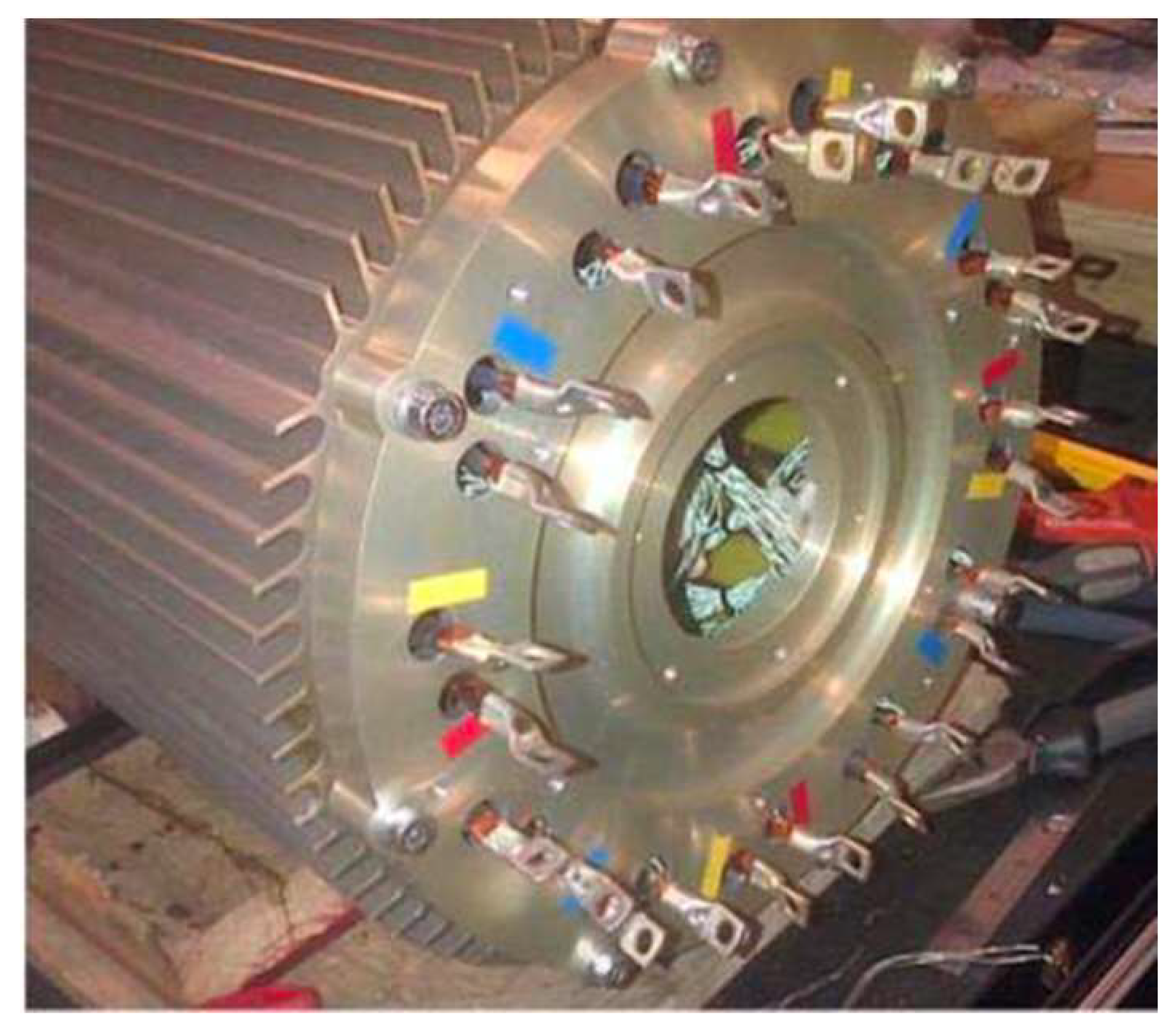


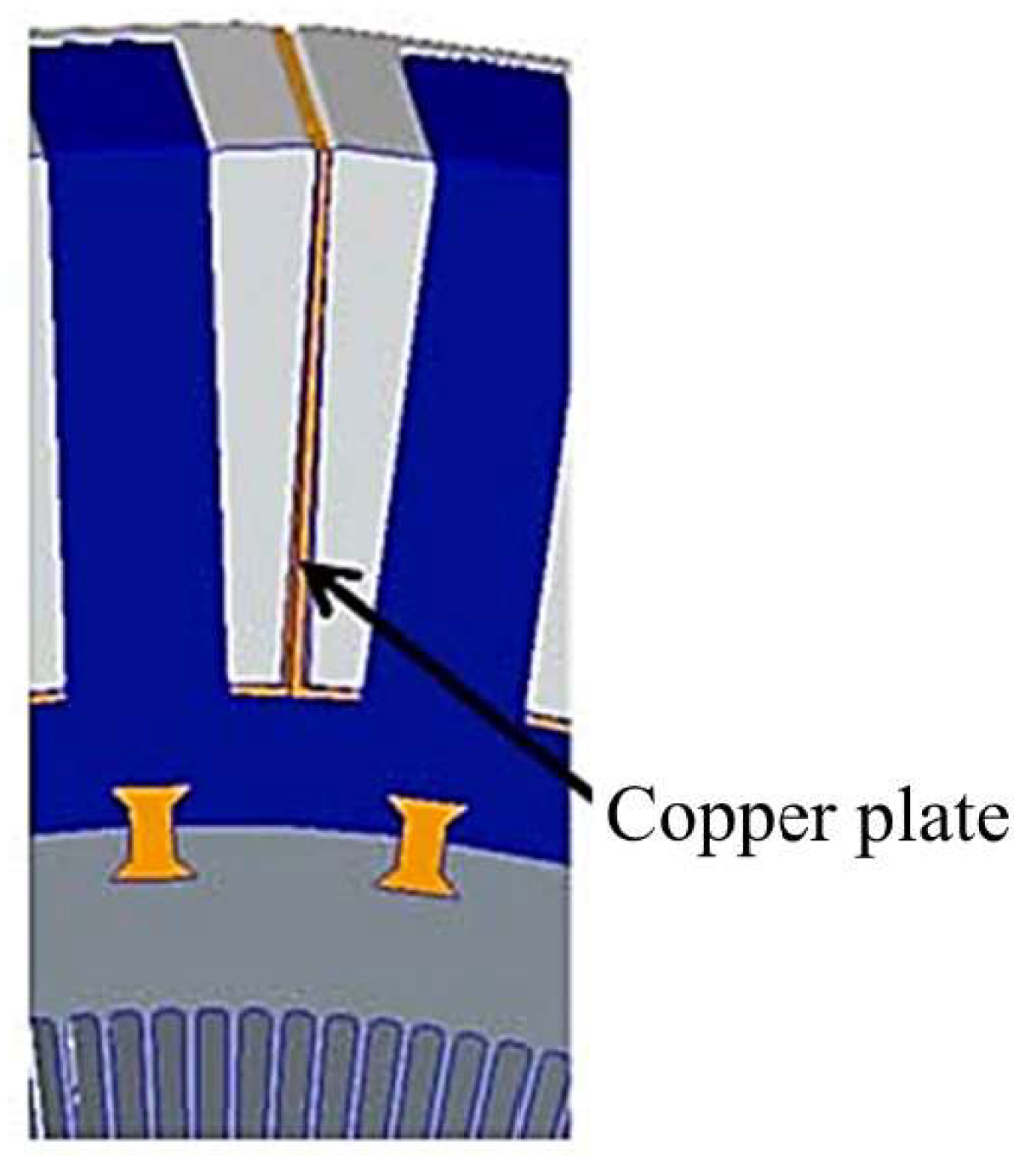

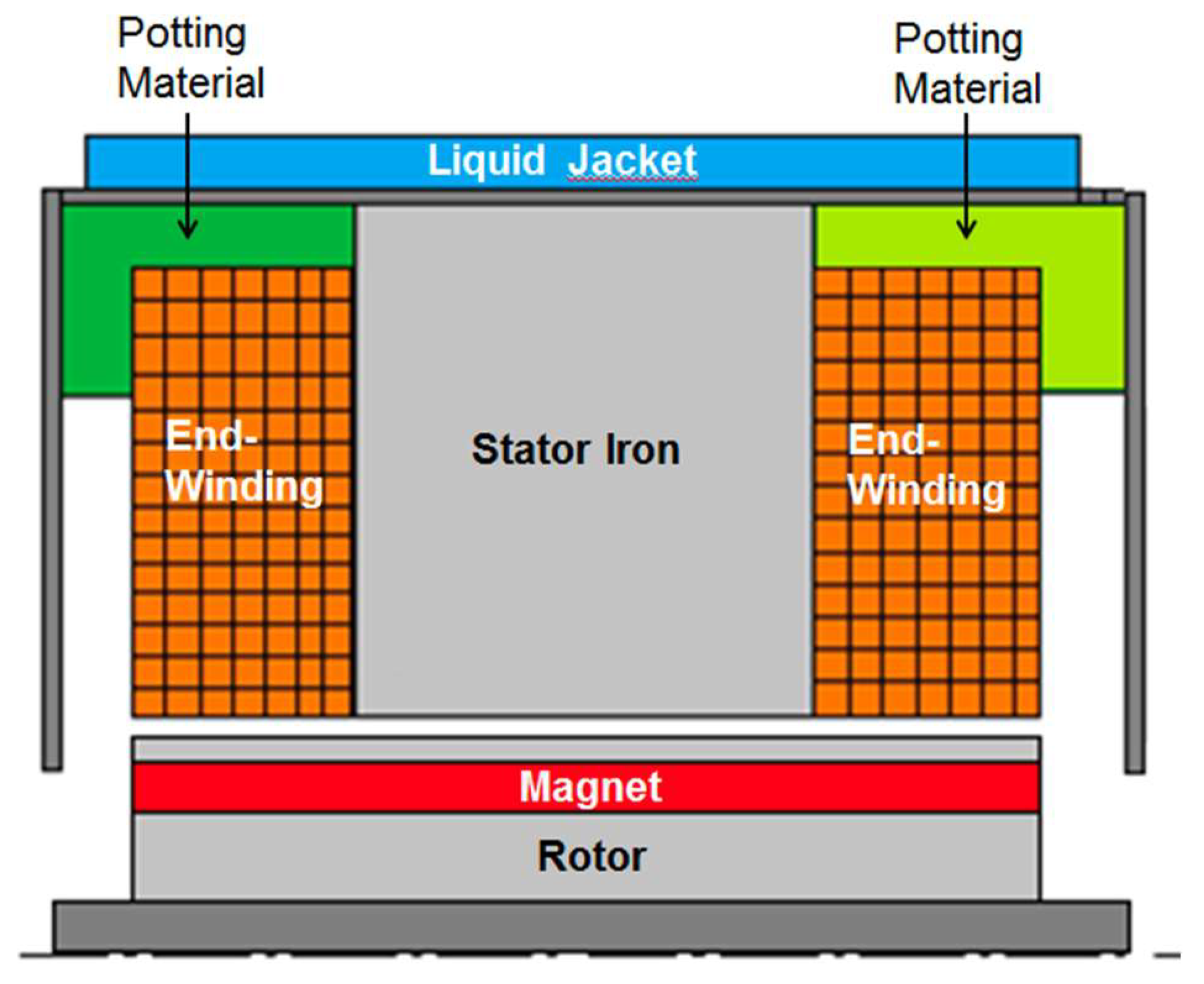
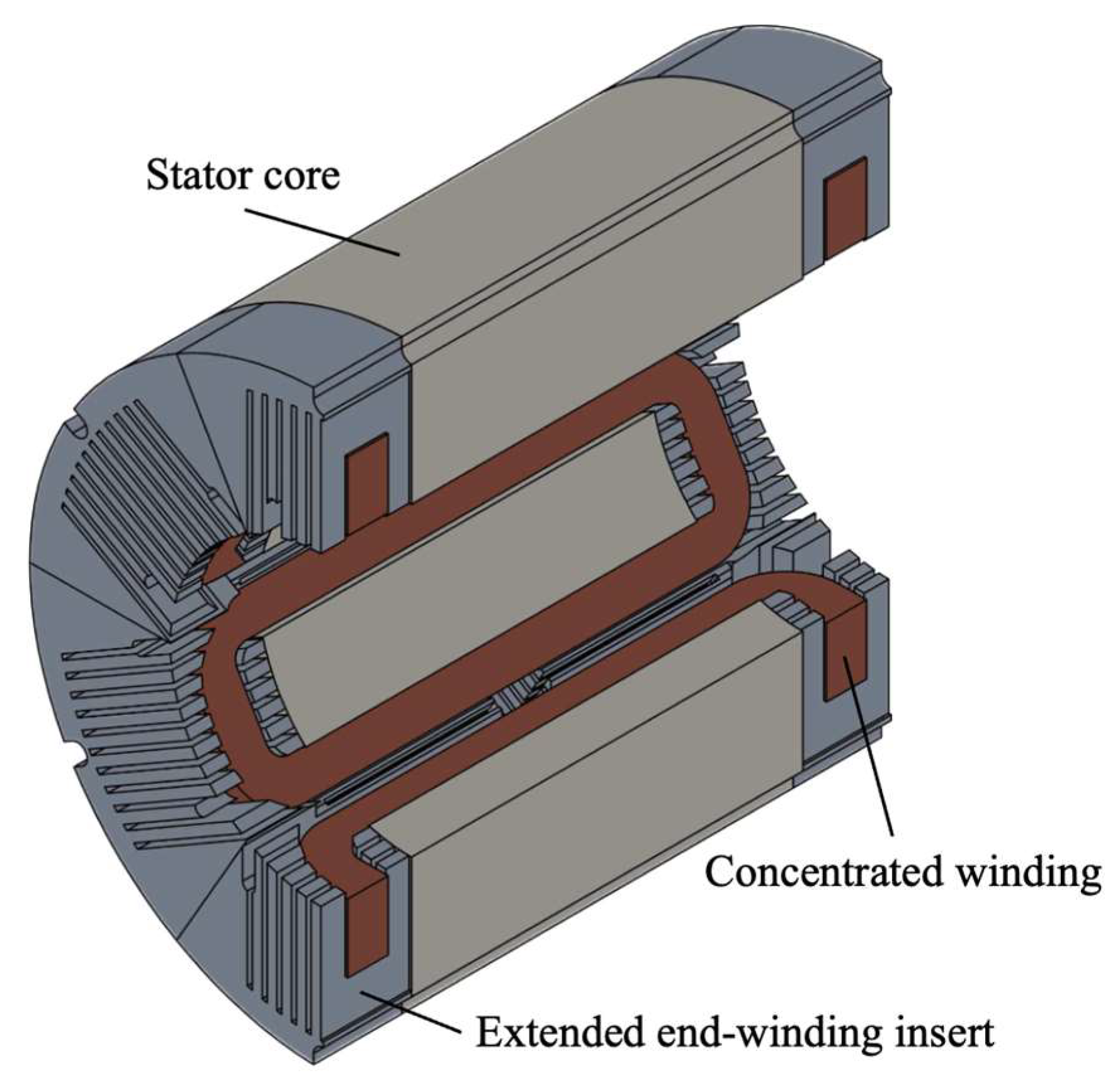




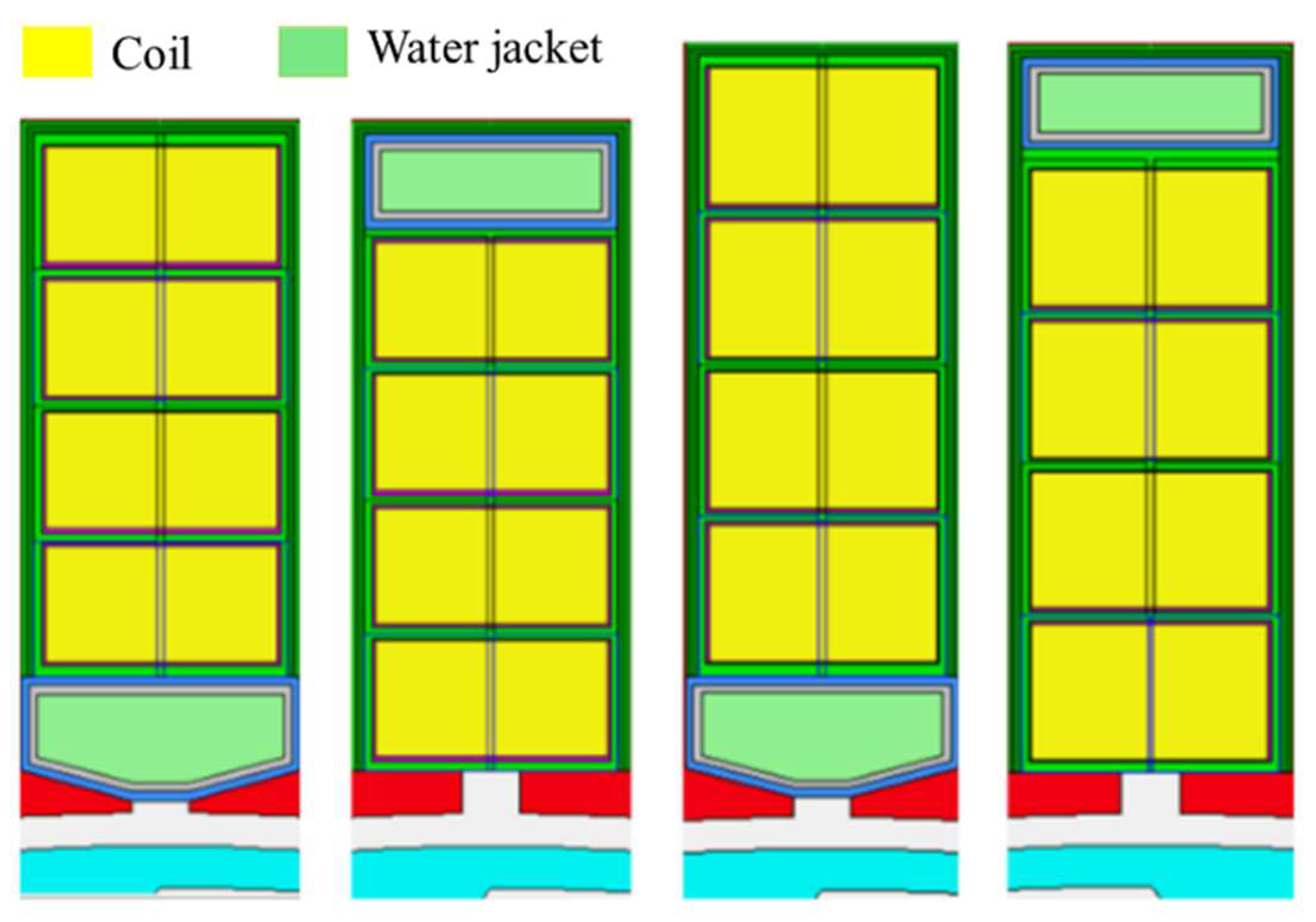

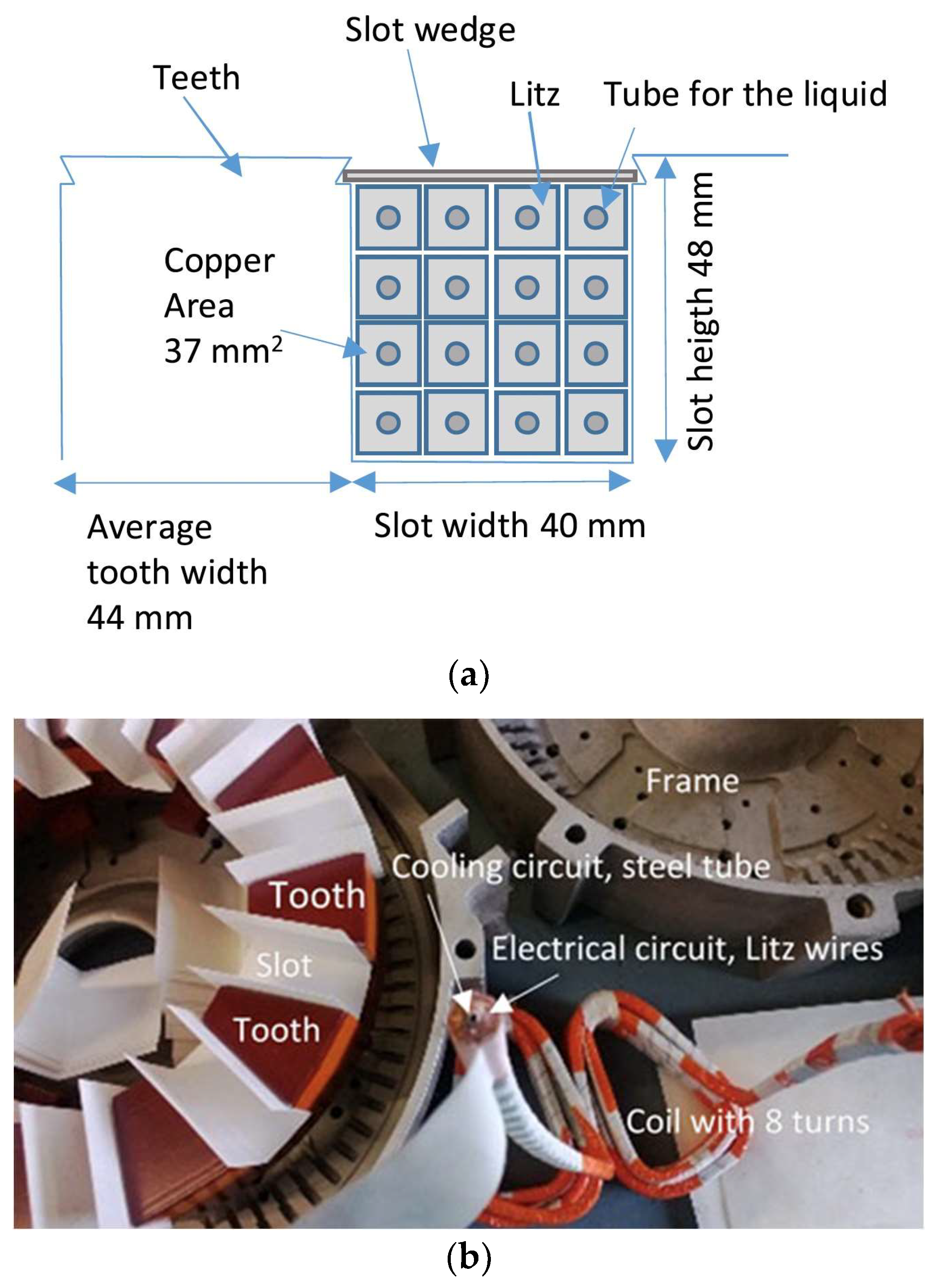
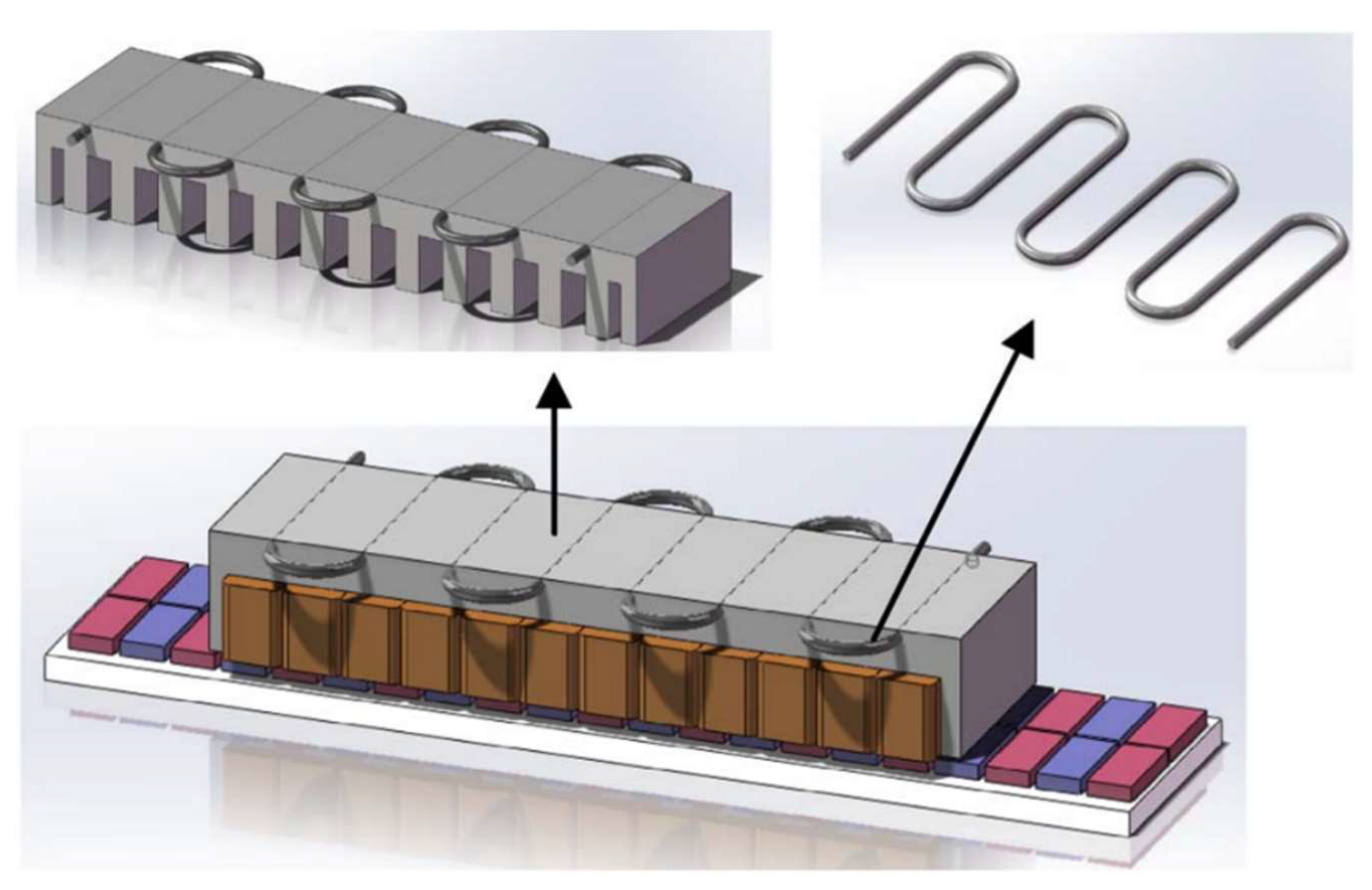
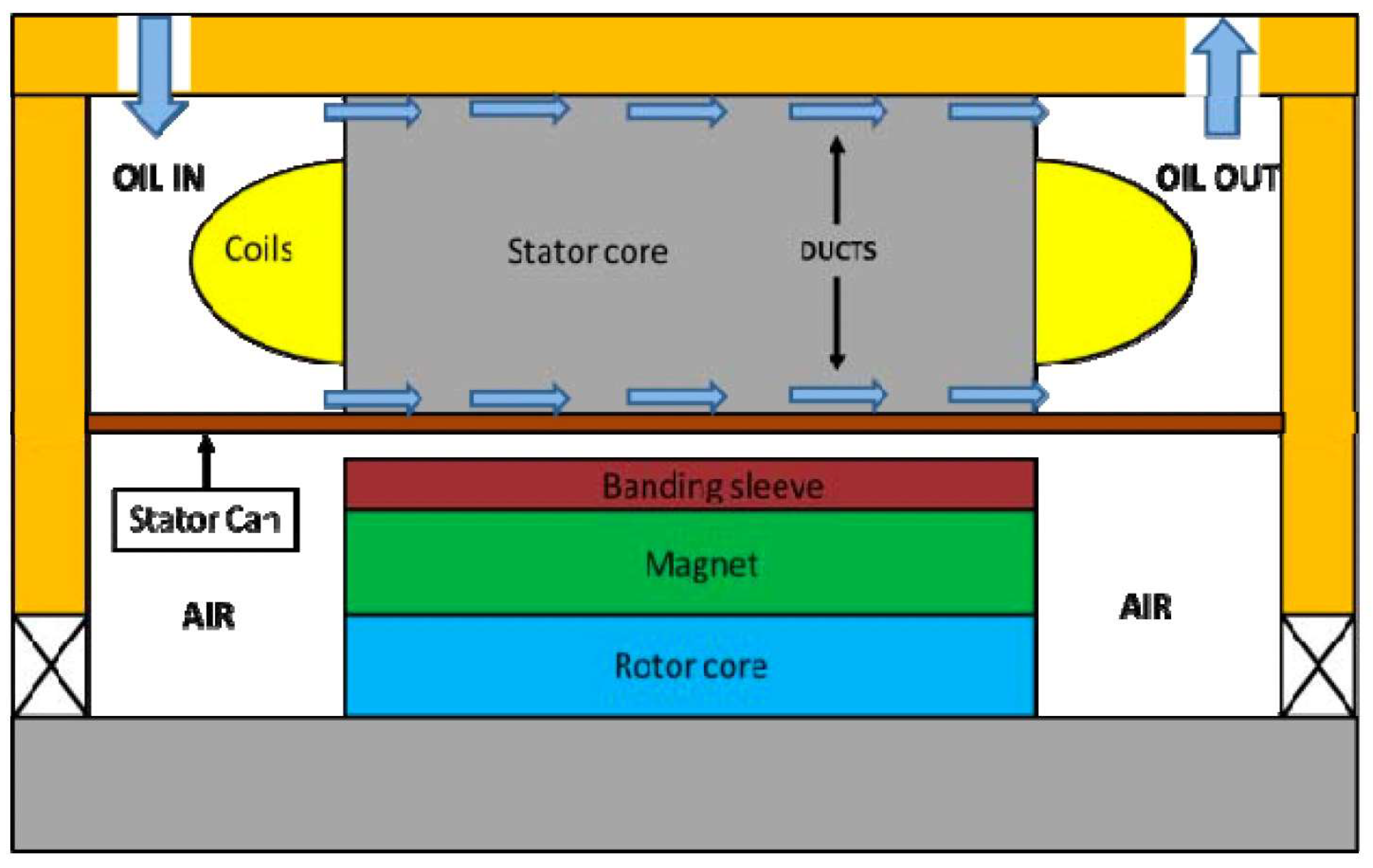
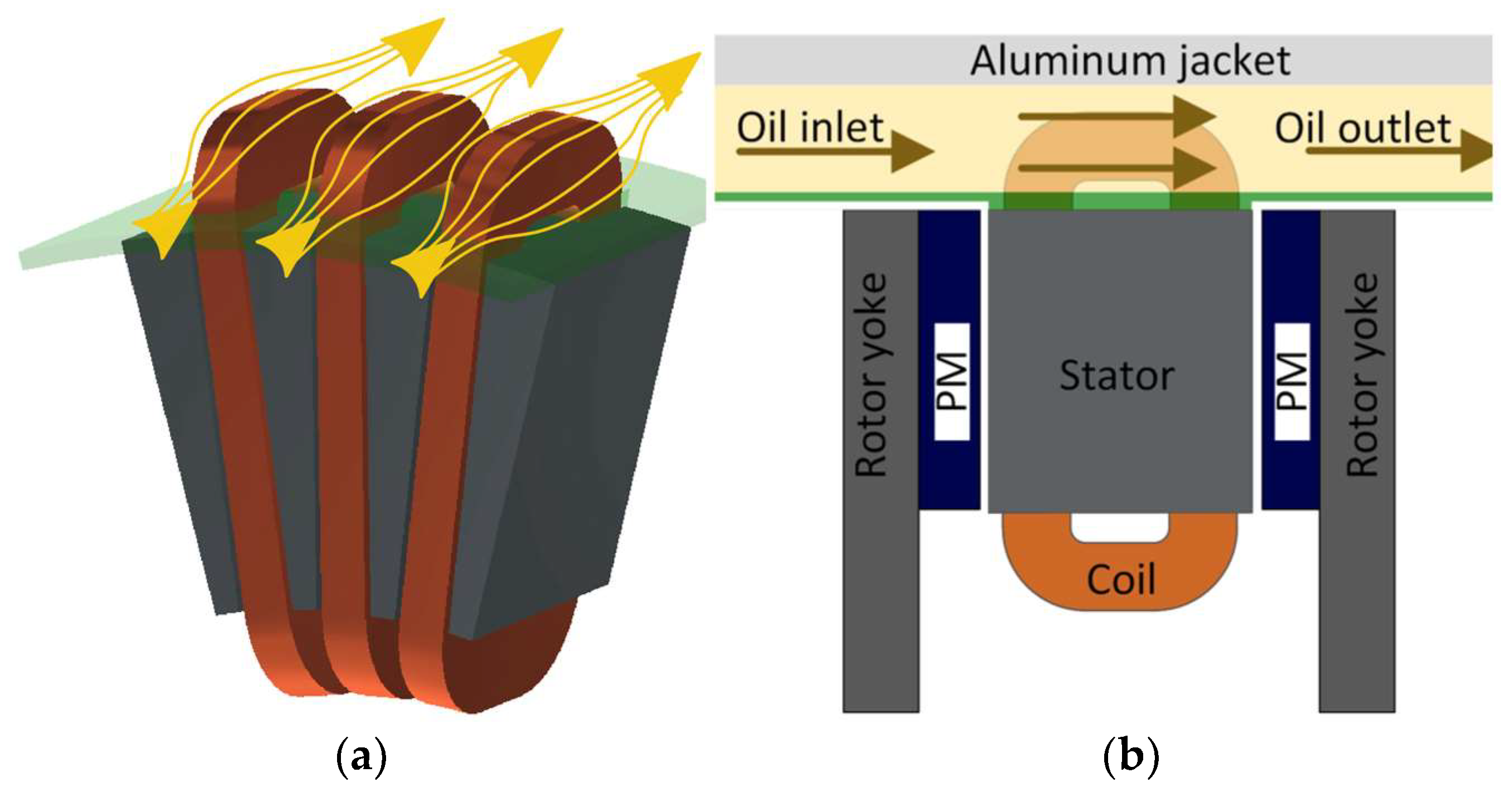
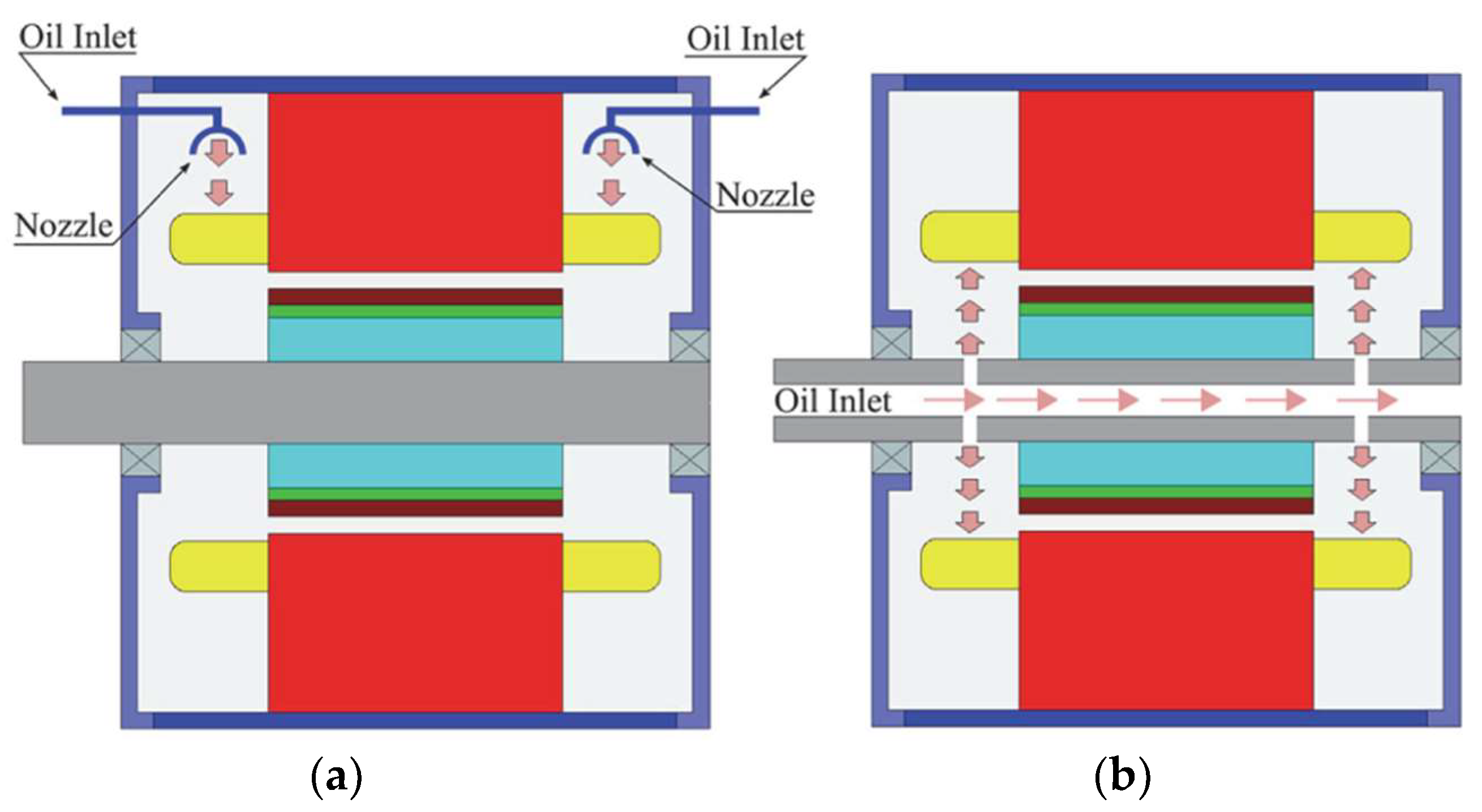
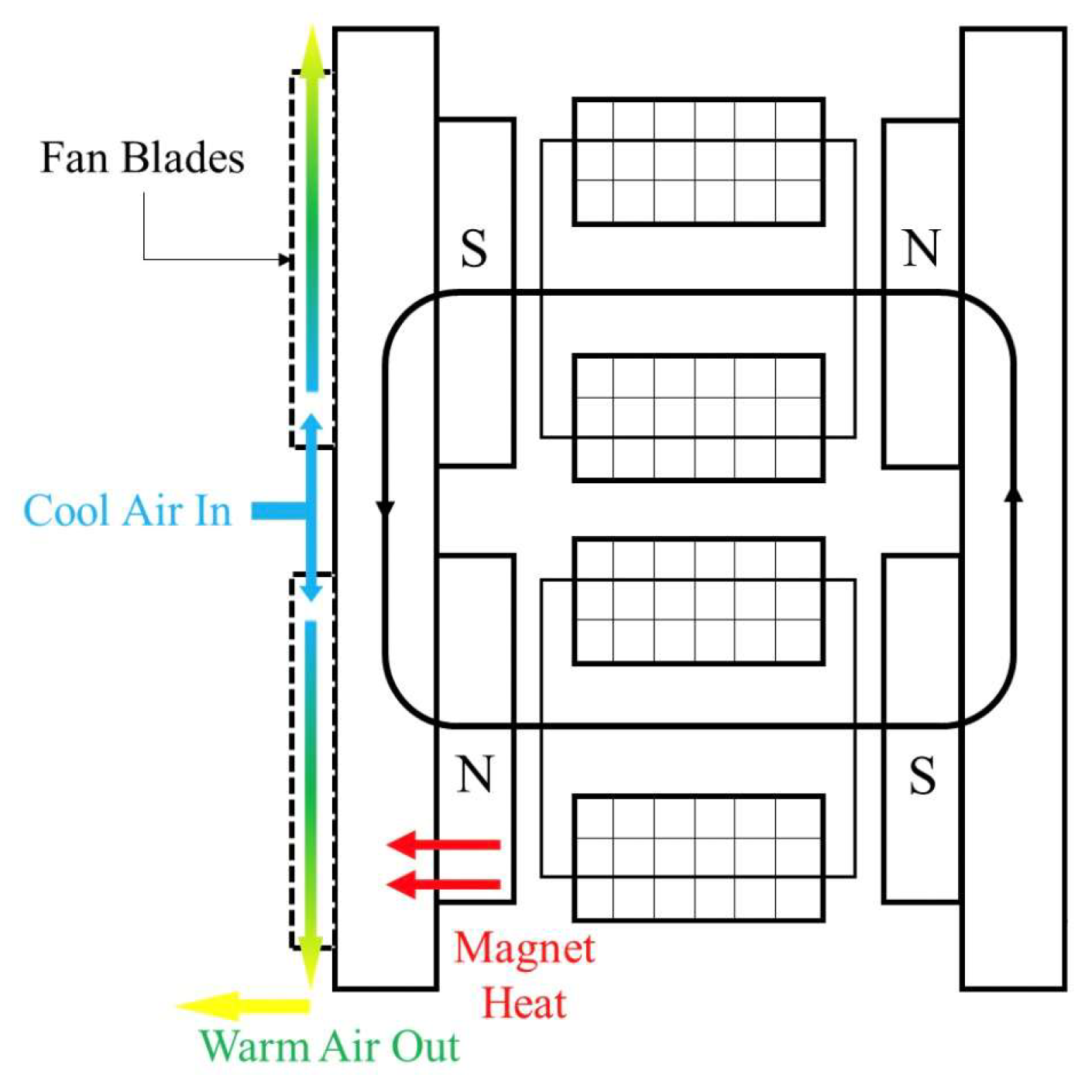
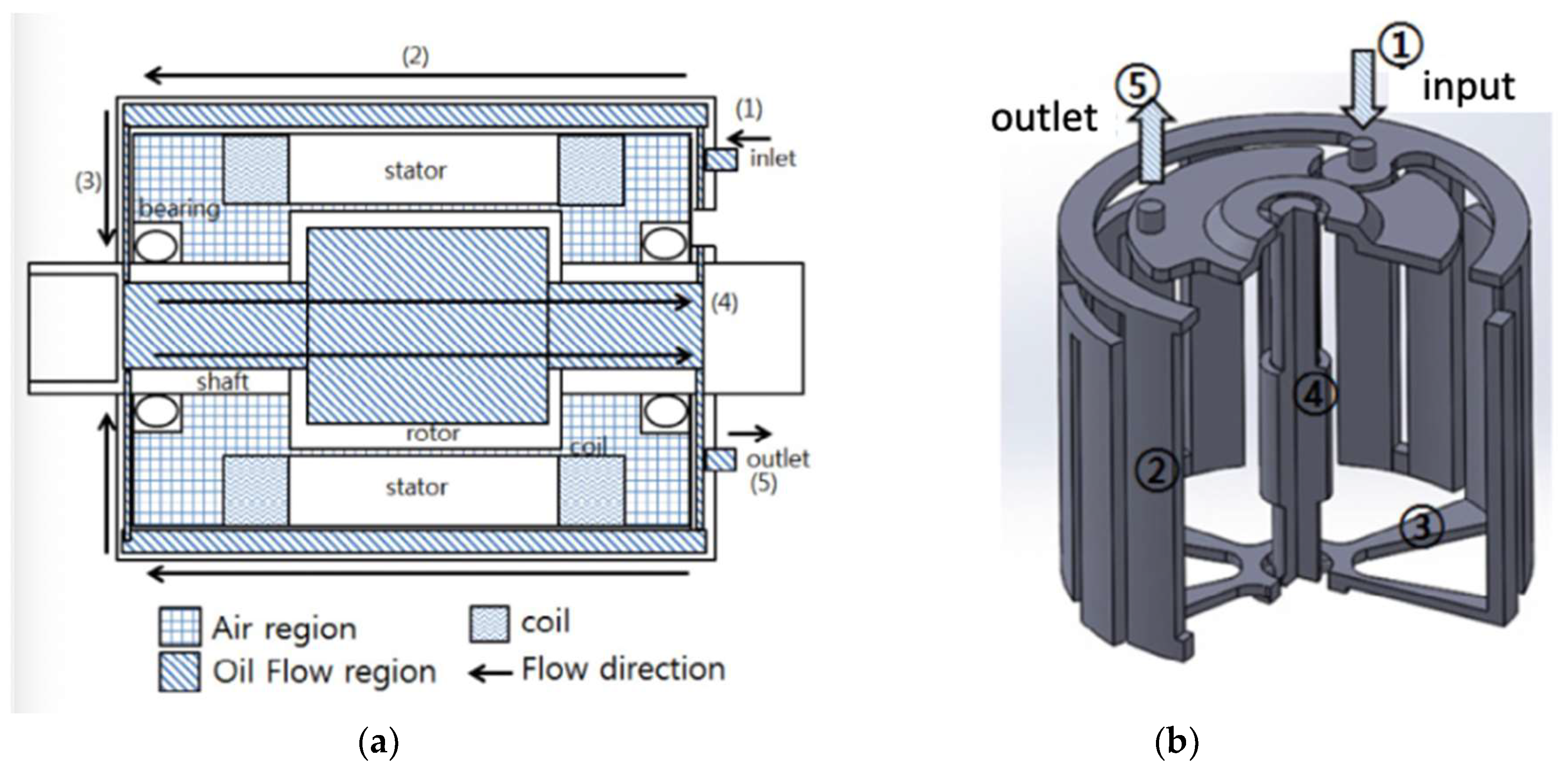
| Cooling System Type | Typical Configurations | Features |
|---|---|---|
| Enclosed housing cooling |
|
|
| Enhanced conductive cooling |
|
|
| Embedded heat pipe cooling |
|
|
| Direct oil cooling |
|
|
| Enhanced rotor cooling |
|
|
| Cooling System Type | Flow Rate | Power | Heat Transfer Coefficient (HTC) | Reference No. |
|---|---|---|---|---|
| Enclosed housing cooling | N/A | 97–239 W | 6.37–7.65 Wm−2 K−1 | [48] |
| 3.5–12.2 m/s (air speed) | 189.3–192.2 W | 26.6–49 Wm−2 K−1 | [49] | |
| Direct oil cooling | 1–6 L/min | N/A | 400–600 Wm−2 K−1 | [41] |
| 5.5 L/min | N/A | 300–600 Wm−2 K−1 | [50] | |
| 1–2 L/min | 80–150 W | N/A | [51] | |
| 0.3–0.9 L/min | 100 W | 1000–6000 Wm−2 K−1 (oil HTC) | [42] | |
| Enhanced rotor cooling | 10 L/min | 557 W (rotor loss) | N/A | [52] |
| Enhanced conductive cooling | 300–800 m3/h (air flow rate) | 2400–3600 W (total loss) | N/A | [27] |
| 5–35 L/min | 3400–5630 W (total loss) | 0–7000 Wm−2 K−1 (convection HTC) | [30] | |
| Embedded heat pipe cooling | 4 L/min | N/A | N/A | [32] |
Publisher’s Note: MDPI stays neutral with regard to jurisdictional claims in published maps and institutional affiliations. |
© 2022 by the authors. Licensee MDPI, Basel, Switzerland. This article is an open access article distributed under the terms and conditions of the Creative Commons Attribution (CC BY) license (https://creativecommons.org/licenses/by/4.0/).
Share and Cite
Wang, Q.; Wu, Y.; Niu, S.; Zhao, X. Advances in Thermal Management Technologies of Electrical Machines. Energies 2022, 15, 3249. https://doi.org/10.3390/en15093249
Wang Q, Wu Y, Niu S, Zhao X. Advances in Thermal Management Technologies of Electrical Machines. Energies. 2022; 15(9):3249. https://doi.org/10.3390/en15093249
Chicago/Turabian StyleWang, Qingsong, Yu Wu, Shuangxia Niu, and Xing Zhao. 2022. "Advances in Thermal Management Technologies of Electrical Machines" Energies 15, no. 9: 3249. https://doi.org/10.3390/en15093249
APA StyleWang, Q., Wu, Y., Niu, S., & Zhao, X. (2022). Advances in Thermal Management Technologies of Electrical Machines. Energies, 15(9), 3249. https://doi.org/10.3390/en15093249







